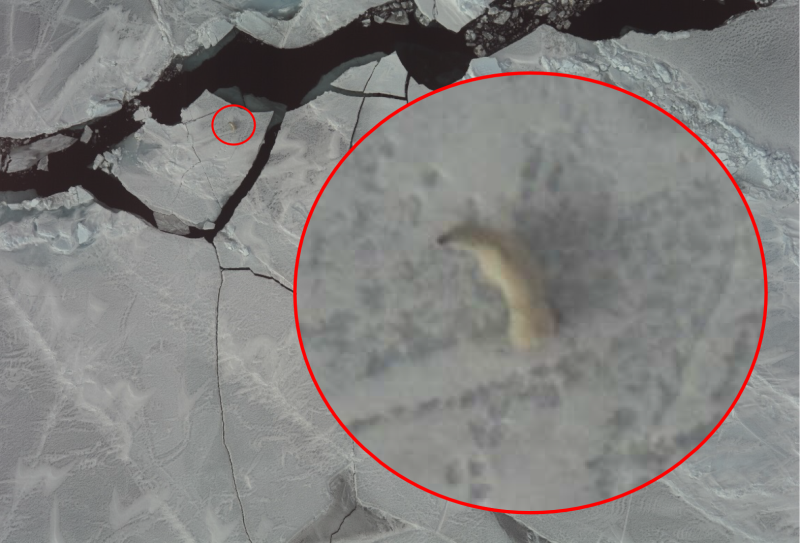Polar bears and seals know no international boundaries. Climate change is rapidly diminishing their sea ice habitat. Results from a joint aerial survey are helping us understand how they’ll respond to these changes— critical information for their conservation and for the subsistence communities that rely on them.
“Our initial plan was to survey ice seals” said study leader Paul Conn, research statistician at NOAA Fisheries’ Alaska Fisheries Science Center. “By collaborating with U.S. Fish & Wildlife Service and Russian partners, we had an opportunity to maximize our resources by simultaneously surveying polar bears.”
In spring 2016, U.S. and Russian scientists conducted the first aerial survey to estimate abundances of polar bears and their ice seal prey over the entire Chukchi sea region. For the first time, they used infrared technology to detect free roaming polar bears. This collaborative, innovative research opens new possibilities for monitoring mammals that range over the vast, remote Arctic, and across international borders.
"The species we worked with are widespread throughout the remote areas of the Chukchi Sea. That makes it extremely challenging to obtain comprehensive and reliable population estimates," said Irina S. Trukhanova, wildlife biologist, North Pacific Wildlife Consulting. “We were very fortunate to have established collaboration with our long-term international partner, NOAA Fisheries. This allowed us to join forces in coordinated surveys, both in the United States and in Russia, within the short period of time when all the species of interest were available to count.”
Chukchi Sea Polar Bears and Climate Change
In 2008, polar bears were listed as threatened under the Endangered Species Act due to loss of sea-ice habitat in a warming Arctic. Ringed and bearded seals, both important polar bear prey, are also listed as threatened.
Chukchi Sea polar bears are one of 19 subpopulations, and are managed under a bilateral treaty between the U.S. and Russia.
“In the United States, polar bears and ice seals are important subsistence resources for Alaska Native communities,” Conn said. “Knowing how many animals exist and where they are is essential to inform conservation efforts and meet international treaty obligations.”
“The Alaska Nannut Co-Management Council applauds this study and the collaborations that made it possible,” said Executive Director Katya Gray. “In addition to the valuable information gained through this research, this effort is significant for its use of non-invasive methods to study polar bears, the importance of which our tribes and hunters are consistently raising. This study also highlights the importance of the U.S.-Russia Agreement for enabling collaborative research between U.S. and Russian scientists, making it possible for us to make better informed management decisions.”
“Before this study, there was limited understanding of the distribution and abundance of this subpopulation,” Conn said. “Most of the previous work involved intensive studies of polar bears in small areas, with findings extrapolated to much larger areas (using data from adult females tagged near Kotzebue, Alaska, for instance). We didn’t have a great idea how reliable such extrapolations were in representing the entire subpopulation.”
Previous Chukchi Sea aerial surveys were restricted to U.S. airspace and limited in spatial coverage. To better understand the distribution and abundance of Chukchi Sea polar bears and their ice seal prey, a new survey approach was needed.
Aerial Spring Surveys and Innovative Technology
Many polar bear aerial surveys are conducted in late summer and early fall, when there is less sea ice and bears are concentrated in smaller areas. In this study, the team used long-ranging airplanes to conduct surveys in the spring.
“During spring, bears are scattered over a larger area, making them more difficult to survey. But it allows us to look at their distribution over sea ice simultaneously with that of their seal prey,” Conn said.
But it is not easy to spot a white bear in a vast icescape. In this study, researchers used thermal cameras to detect the warm bodies of animals on sea ice. Infrared technology has previously proven highly effective for surveying seals on sea ice. Until this survey, it had never been used to detect free ranging polar bears.
The team combined infrared imagery with digital photography and direct visual observation to detect and identify bears, bear tracks, and seals. From these data they created models relating bear and track densities to environmental factors such as sea ice extent to predict abundance and distribution throughout the study area.
The survey has already yielded new findings that increase our understanding of Chukchi Sea polar bears.
“Our abundance estimate (3,435–5,444 bears) was of similar magnitude to densities extrapolated from the Kotzebue, Alaska region, but differed in where bears were predicted to be. One surprise was finding high densities of bears concentrated in Russian waters between Wrangell Island and the Chukotka Peninsula. We didn’t know quite how important that area was before,” Conn said.
“The results of this study indicate a healthy Chukchi sea polar bear subpopulation,” Gray said. “That is good news for our communities that rely on polar bears for subsistence.”
But the greatest value of the study is in improving our ability to monitor the response of Arctic mammals as climate change continues. Ice seals in Alaska have also experienced elevated mortalities in recent years. This has led to two Unusual Mortality Event declarations—one prior to this survey and one more recently.
“This collaborative study provides a new approach with promising possibilities,” Conn said. “With future improvements, springtime aerial surveys can greatly increase our understanding of the spatial dependence between polar bear and seal populations, and inform conservation and management efforts into the future.”
This research is a collaborative effort between NOAA Fisheries, Alaska Fisheries Science Center (Paul Conn, Erin E. Moreland, Peter Boveng); Autonomous Non-Commercial Organization, Ecological Center, Russia (Vladimir Chernook, Alexander Vasiliev); North Pacific Wildlife Consulting, LLC, U.S. (Irina Trukhanova); United States Fish and Wildlife Service, Marine Mammals Management, Alaska, U.S (Eric Regehr,Ryan Wilson); Polar Science Center, University of Washington, U.S. (Eric Regehr); All-Russian Research Institute for Nature Protection, Russia (Stanislav Belikov).









